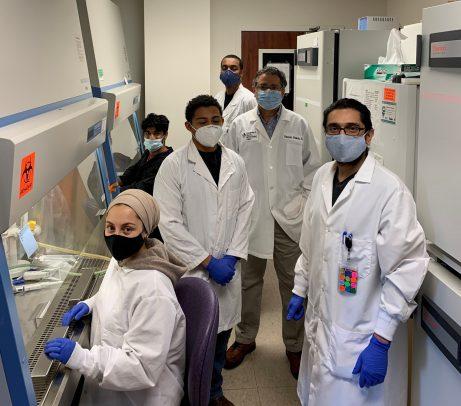A drug currently prescribed to treat a rare enzyme deficiency can help cells clear the herpes simplex 1 and herpes simplex 2 viruses

Credit: University of Illinois Chicago
A drug currently prescribed to treat a rare enzyme deficiency can help cells clear the herpes simplex 1 and herpes simplex 2 viruses, according to a new study published in the journal Science Advances.
The new data shows that the antiviral activity of the drug — called phenylbutyrate, or PBA — was even better when used along with acyclovir, a common HSV-1 treatment. When used in combination, less acyclovir is needed to effectively suppress the virus compared to acyclovir alone — this is important because acyclovir is also known to have toxic side effects in the kidneys.
“There are very few drugs available to treat herpes simplex viruses, so when new drugs become available, especially drugs that enable fewer side effects, it is a welcome discovery,” said Dr. Deepak Shukla, the Marion Schenk Professor of Ophthalmology and UIC professor of microbiology and immunology at the College of Medicine and corresponding author on the paper. “Acyclovir can have very toxic effects on the kidneys, especially when it is given in higher doses for HSV-induced encephalitis, which is rare but can be deadly. By combining acyclovir with PBA, we need less acyclovir to effectively treat HSV-1.”
There are two types of herpes simplex virus: herpes simplex 1, which infects the eyes and mouth and is a leading cause of blindness, and herpes simplex 2, a genital infection that may cause painful sores and can seriously impair quality of life.
Treatment for both infections often includes acyclovir — a systemic medication taken orally. However, long-term use often results in resistance to the drug as well as kidney damage.
Shukla and colleagues investigated the antiviral effects of PBA and found that in cells the drug disrupts the ability of the virus to hijack the cellular machinery used to produce proteins. Normally, viruses infect cells and force them to produce viral proteins so the virus can replicate itself. But the cell also continues to produce proteins for its own use, leading to a lot of stress in the structure — called the endoplasmic reticulum, or ER for short — that makes protein.
“We found that PBA reduces stress on the ER, which allows the cell to focus on clearing the virus on its own,” said Tejabhiram Yadavalli, a UIC ophthalmology and visual sciences postdoctoral fellow and first author of the paper.
The researchers found that in cells, PBA alone was able to clear HSV-1 from cells of donated human corneas or from donated human skin tissue just as well as acyclovir. In a mouse model of ocular HSV-1 infection, PBA administered intraperitoneally was able to clear the virus from the eyes.
In an animal model of HSV-2 vaginal infection, mice that received PBA had no signs of the HSV-2 virus in tissues, similar to mice treated with acyclovir.
When they tested a combination of PBA with acyclovir cells infected with HSV-1, the drug combo was able to completely clear the virus from the cells faster and better than either drug alone. Additionally, in a mouse model of HSV-induced encephalitis, mice treated with PBA or acyclovir alone had significantly reduced death rates, but a combination of PBA and acyclovir was able to prevent death in all mice given this combination.
“PBA is an exciting new therapeutic for treating herpes infections that can help reduce side effects associated with long term or high dose use of acyclovir, a commonly prescribed medication to treat herpes viruses,” Shukla said. “The added bonus of this drug already being approved by the FDA to treat a rare enzyme disorder means that we may be able to quickly develop a marketable new combination therapy in the near future.”
###
Rahul Suryawanshi, Raghuram Koganti, James Hopkins, Joshua Ames, Lulia Koujah, Aqsa Iqbal, Krishna Raju and Alex Agelidis of UIC are co-authors on the paper.
This work was funded by grants from National Institutes of Health (R01EY024710 and R01 AI139768), an NIH Fellowship, and funds from Research to Prevent Blindness.
Media Contact
Lori Botterman
[email protected]
Original Source
https:/
Related Journal Article
http://dx.




